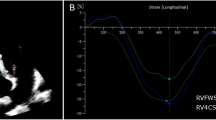Summary
The function of the transplanted heart will be affected by acute allograft rejection, chronic rejection, high blood pressure and so on, which may induce the reconstruction of the left ventricle and the increase of left ventricular mass (LVM), and eventually lead to left ventricular hypertrophy that will significantly affect the prognosis of heart transplantation (HT). The purpose of this study was to dynamically monitor the changes of left ventricular geometric patterns after HT using two-dimensional echocardiography and to understand the remodeling process and its possible influencing factors. The left ventricular internal diameter, interventricular septal wall thickness, posterior wall thickness at end diastole were measured and the relative wall thickness (RWT), left ventricular mass, left ventricular mass index were calculated respectively in 34 HT patients and 34 healthy volunteers by two-dimensional echocardiography. The type of left ventricular geometry was identified based on the echocardiographic determination of LVM index (LVMI) and RWT. The HT patients were divided into three groups according to the time length after surgery: A (3 months postoperatively), B (6 months postoperatively) and C (12 months postoperatively). We compared the parameters of left ventricle between HT group and normal control group, and explored the risk factors causing the increase of LVM. The results showed that 4 patients (16%) in group A had concentric remodeling. Nine patients (34.62%) in group B had reconstruction, including 5 cases of concentric remodeling, 2 cases of concentric hypertrophy and 2 cases of eccentric hypertrophy. The hypertrophy incidence rate was 15.4% in group B. 15 patients (62.5%) had reconstruction in group C, including 9 cases of concentric remodeling, 5 cases of concentric hypertrophy, and 1 case of eccentric hypertrophy. The prevalence of hypertrophy was 25%. Multivariate analysis showed that hypertension and acute rejection history were the risk factors that resulted in left ventricular hypertrophy. It is concluded that the left ventricular remodeling occurs following cardiac transplantation at an early stage and the incidence of left ventricular hypertrophy increases with survival time. In this study, the one-year prevalence of left ventricular hypertrophy was 25% after surgery. Hypertension and acute rejection history are risk factors that can predict the left ventricular hypertrophy.
Similar content being viewed by others
References
McKoy RC, Uretsky BF, Kormos R, et al. Left ventricular hypertrophy in cyclosporine-induced systemic hypertension after cardiac transplantation. Am J Cardiol, 1988,62(16):1140–1142
Ventura HO, Lavie CJ, Messerli FH, et al. Cardiovascular adaptation to cyclosporine-induced hypertension. J Hum Hypertens, 1994,8(4):233–237
Calò L, Semplicini A, Davis PA, et al. Cyclosporin-induced endothelial dysfunction and hypertension: are nitric oxide system abnormality and oxidative stress involved? Transpl Int. 2000,13( Suppl 1):413–418
Verdecchia P, Carini G, Circo A, et al. Left ventricular mass and cardiovascular morbidity in essential hypertension: the MAVI study. J Am Coll Cardiol, 2001,38(7): 1829–1835
Verdecchia P, Porcellati C, Reboldi G, et al. Left ventricular hypertrophy as an independent predictor of acute cerebrovascular events in essential hypertension. Circulation, 2001,104(17):2039–2044
Goodroe R, Bonnema D, Lunsford S, et al. Severe left ventricular hypertrophy 1 year after transplant predicts mortality in cardiac transplant recipients. J Heart Lung Transplant, 2007,26(2):145–151
Taler SJ, Textor SC, Canzanello VJ, et al. Cyclosporin-induced hypertension: incidence, pathogenesis, and management. Drug Saf, 1999,20(5):437–449
Lang RM, Bierig M, Devereux RB. Recommendations for chamber quantification. J Am Soc Echocardiogr, 2005,18(12):1440–1463
Trulock EP, Edwards LB, Taylor DO, et al. Registry of the International Society for Heart and Lung Transplantation: twenty-second official adult lung and heart-lung transplant report—2005. J Heart Lung Transplant, 2005,24(8):956–967
Liao Y, Cooper RS, Durazo-Arvizu R, et al. Prediction of mortality risk by different methods of indexation for left ventricular mass. J Am Coll Cardiol, 1997,29(3):641–647
Haider AW, Larson MG, Benjamin EJ, et al. Increased left ventricular mass and hypertrophy are associated with an increased risk for sudden death. J Am Coll Cardiol, 1998,32(5):1454–1459
Borow KM, Neumann A, Arensman FW, et al. Left ventricular contractility and contractile reserve in humans after cardiac transplantation. Circulation, 1985,71(5): 866–872
Mclaughlin PR, Kleiman JH, Martin RP, et al. The effect of exercise arterial pacing on left ventricular volume and contractility in patients with innervated and denervated hearts. Circulation, 1978,58(3):476–483.
Stinson EB, Griepp RB, Clark DA, et al. Cardiac transplantation in man. 8. Survival and function. J Thorac Cardiivasc Surg, 1970,60(3):303–321
Sagar KB, Hastillo A, Wolfgang TC, et al. Left ventricular mass by M-mode echocardiography in cardiac transplant patients with acute rejection. Circulation, 1982,64(suppl II):211–216
Schwitter J, De Marco T, Globits S, et al. Influence of felodipine on left ventricular hypertrophy and systolic function in orthotopic heart transplant recipients: possible interaction with cyclosporine medication. J Heart Lung Transplant, 1999,18(10):1003–1013
Globits S, DeMarco T, Schwitter J, et al. Assessment of early left ventricular remodeling in orthotopic heart transplant recipients with cine magnetic resonance imaging: potential mechanisms. J Heart Lung Transplant, 1997,16(5):504–510
Corcos T, Tamburino C, Leger P, et al. Early and late hemodynamic evaluation after cardiac transplantation: A study of 28 cases. JACC, 1988,11(2):264–269
Czerska B, Stewart RW, Hobbs RE, et al. Hypertension and left ventricular hypertrophy in black vs. white heart transplant patients 1 year after surgery. Ethn Dis, 1991,1(4): 335–341
Peura JL, Zile MR, Feldman DS, et al. Effects of conversion from cyclosporin to tacrolimus on left ventricular structure in cardiac allograft recipients. J Heart Lung Transplant, 2005,24(11):1969–1972
Schwitter J, DeMarco T, Globits S, et al. Influence of felodipine on left ventricular hypertrophy and systolic function in orthotopic heart transplant recipients: possible interaction with cyclosporin medication. J Heart Lung Transplant, 1999,18(10):1003–1013
Guo JH. Heart transplantation and electrocardiogram. Lin Chuang Xin Dian Xue Za Zhi (Chinese), 2004,13(3): 223–229
Author information
Authors and Affiliations
Corresponding author
Additional information
This project was supported by a grant from the National Natural Science Foundation of China (No. 30901478).
Rights and permissions
About this article
Cite this article
Qin, Xj., Li, H., You, J. et al. Left ventricle geometry remolding after heart transplantation: A two-dimensional ultrasound study. J. Huazhong Univ. Sci. Technol. [Med. Sci.] 33, 892–896 (2013). https://doi.org/10.1007/s11596-013-1217-5
Received:
Revised:
Published:
Issue Date:
DOI: https://doi.org/10.1007/s11596-013-1217-5




